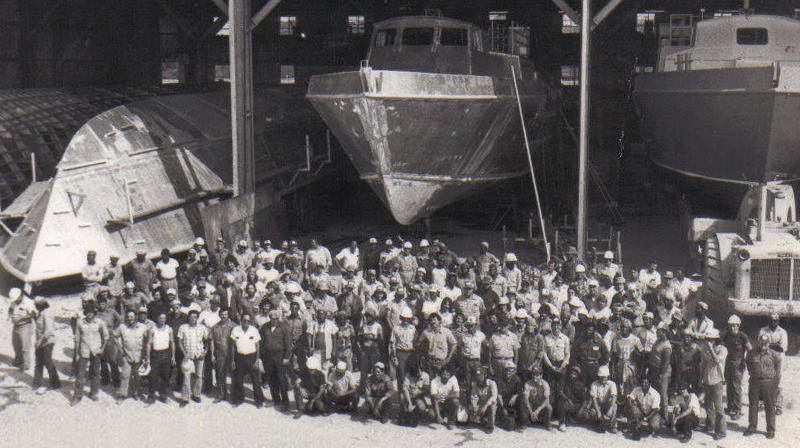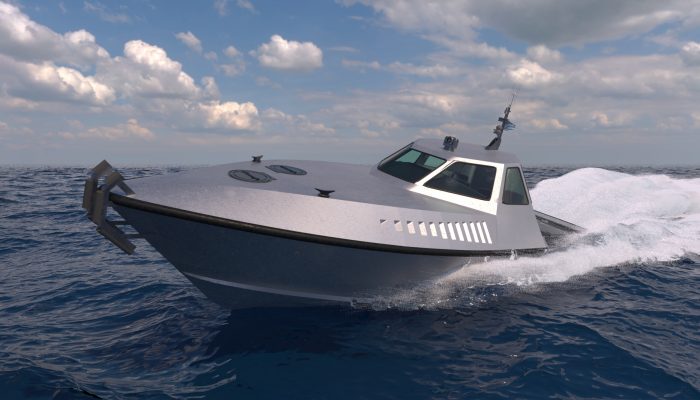Remembering the 193 Swift Boats
Swiftships became a key supplier of “Swift Boats” to the US Navy during the Vietnam War. The main mission objective of the Swift Boat was to provide the Navy with a fast boat that could patrol many miles of the river shores. The Swiftships’ Patrol Boat allowed navigation of short river channels that were inaccessible to most small boat designs at the time. Swiftships delivered 193 patrol boats to the US Navy throughout the Vietnam conflict, creating a reputation as an excellent and trusted supplier of shallow water hulls.
Sewart Seacraft of Berwick, Louisiana (Swiftships‘ predecessor), built water taxis for companies operating oil rigs in the Gulf of Mexico, which appeared nearly ideal. The Navy bought their plans, and asked Sewart Seacraft to prepare modified drawings that included a gun tub, ammo lockers, bunks, and a small galley. The Navy used those enhanced plans to request bids from other boat builders. Sewart Seacraft was chosen to build the boats.
The Patrol Craft Fast (PCF), also called Swift Boats, were shallow-draft vessels made of aluminum and measuring 50 feet (15 m) in length. Originally used by the United States Navy to patrol coastal areas, they later became a key part of the brown-water navy, tasked with intercepting Vietcong movement of arms and munitions, transporting South Vietnamese forces, and inserting SEAL teams for counterinsurgency (COIN) operations during the Vietnam War.
Specifications and Design Modifications
Mark I
The Swift Boats had welded aluminum hulls about 50 feet (15 m) long with 13 feet (4.0 m) beam, and draft of about five feet (1.5 m). They were powered by a pair of General Motors 12V71″N” Detroit marine diesel engines rated at 480 horsepower (360 kW) each, with a design range from 320 nautical miles (590 km) at 21 knots (39 km/h) to about 750 nautical miles (1,390 km) at 10 knots (19 km/h). The first two PCFs were delivered to the Navy in late August 1965.
Armament. The original water taxi design had been enhanced with two .50 caliber M2 Browning machine guns in a turret above the pilot house, an over-and-under .50-caliber machine gun – 81 mm mortar combination mounted on the rear deck. The 81 mm combination mortar mounted on the rear deck was not a gravity firing mortar as used by the Army and Marine Corps, in which the falling projectile’s primer struck the fixed firing pin at the base of the mortar tube, but a unique lanyard firing weapon in which the projectile was still loaded into the muzzle. The gunner could “fire at will” by the use of the lanyard. The weapon had been tested in the 1950s and discarded as the U.S. Navy lost interest in the system. The United States Coast Guard maintained the gun/mortar system before the Navy incorporated it into the PCF program.[1][2] Many boats also mounted a single M60 machine gun in the forward peak tank, just in front of the forward superstructure. The original order for 50 boats was followed shortly by an additional order for 54 more Mark Is.
Mark II and Mark III
In the latter half of 1967, 46 Mark II boats, with a modified deck house set further back from the bow. The newer boats also had round port holes (replacing larger sliding windows) in the aft superstructure. From 1969 through 1972, 33 Mark IIIs, which were a larger version of the Mark IIs, arrived in Vietnam.
Swift Boat Missions in Vietnam
The first Swift Boats arrived in South Vietnam in October 1965. The boats were initially used as coastal patrol craft in Operation Market Time, interdicting seaborne supplies on their way to the Viet Cong (VC) and People’s Army of Vietnam (PAVN) forces in South Vietnam. However, the design’s shallow draft and low freeboard limited their seaworthiness in open waters. These limitations, plus the difficulties being encountered in the interior waterways by the smaller, more lightly armed PBRs, led to the incorporation of Swifts to patrol the 1,500 miles (2,400 km) of rivers and canals of Vietnam’s interior waterways.
Swift Boats continued to operate along the Vietnamese coastal areas, but with the start of Admiral Elmo Zumwalt’s “SEALORDS” riverway interdiction strategy, their primary area of operations soon centered upon the Cà Mau Peninsula and the Mekong Delta area in the southern tip of Vietnam. Here they patrolled the waterways and performed special operations, including gunfire support, troop insertion and evacuation, and raids into enemy territory.
The Mekong Delta is composed of ten thousand square miles of marshland, swamps and forested areas. The region is interlaced by rivers and canal ways. Controlled by the VC, the interior waterways of the Mekong Delta were used to transport supplies and weapons. Swift Boats generally operated in teams of three to five. Each boat had an officer in charge, one of whom would also be placed in overall charge of the mission. Their missions included patrolling the waterways, searching water traffic for weapons and munitions, transporting South Vietnamese marine units and inserting Navy SEAL teams.
When the Swift Boats began making forays up the waterways into the interior of the delta, they initially took the carriers by surprise, causing them to drop their materials and run off into the overgrowth. Occasionally a short firefight would break out. As it became clear that control of the waterways was being contested, the VC developed a number of tactics to challenge the U.S. Navy. They set up ambushes, built obstructions in the canals to create choke points and began to place mines in the waterways. For the Swifts, coming back down river was always more dangerous than going up river. The passage of a patrol assured their eventual return, providing an opportunity for the VC. Ambushes were typically short lived affairs, set up at a river bend or in a narrow canal that restricted the maneuverability of the boats.
A wide variety of portable weapons were used in attacks, including recoilless rifles, B-40 rockets, .50 caliber machine guns and AK-47s, often fired from behind earthen bunkered positions. Engagements were brief and violent, with the ambushers often slipping away into the undergrowth when the boats located the source of attack and began to concentrate their return fire. When attacked the boats would accelerate out of the hot zone, turn and then return as a group, firing as many of their guns as they could bring to bear. They would power past the ambush point, turn and return to attack again until the ambushers were either killed or slipped away. Though most cruising and patrolling was done at 8 to 10 knots, the boats could reach a top speed of 32 knots. Thick brush and vegetation in the delta provided excellent cover for the escaping ambushers. Casualties taken among the river crews were high.
Exceptional Durability and Current Days
In 2014, Swift boats were still active in the Vietnam People’s Navy, who acquired a number of vessels from the Republic of Vietnam’s naval forces. The South Vietnamese Navy carried out several modifications to the vessel’s armament. The American M2 machine gun was replaced by a domestically produced 12.7 mm NSV gun, which had fewer jamming problems and was easier for the crews to maintain. The electronic and communication systems were also overhauled.
There are two operational Patrol Craft Fast (PCF) boats in the United States today. R/V Matthew F. Maury, formerly PCF-2, is operated by Tidewater Community College in Virginia Beach, Virginia. The vessel was awarded to the college in 1995 and has been used in oceanographic research and education since then. It is berthed at JEB Little Creek and operates in and around Chesapeake Bay. The second operational PCF, PCF-816 (formerly P-24 in the service of Malta), is operational in San Diego, California, at the Maritime Museum of San Diego. The boat makes regular runs on weekends and is staffed with former crew members of Swift Boats as guides.
There are two Swift Boats preserved in static displays in the United States. Both are former U.S. Navy Swift Boats that were originally stationed in California to train PCF crews. One is located at the Navy Museum at Washington Navy Yard in Washington, D.C.; the other Swift Boat is on the Naval Special Weapons Base at Naval Amphibious Base Coronado, California, which was the original home of PCF training.
References
- Wells II, William R. (August 1997). “The United States Coast Guard’s Piggyback 81mm Mortar/.50 cal. machine gun”. Vietnam Magazine. Retrieved 16 January 2012.
- ^ Bob Stoner. “Notes on Mk 2 Mod 0 and Mod 1 .50 Caliber MG/81mm Mortar”.
- ^ Jump up to:a b c “PCF 816 Swift Boat”. Maritime Museum of San Diego. Archived from the original on 2015-09-06. Retri




